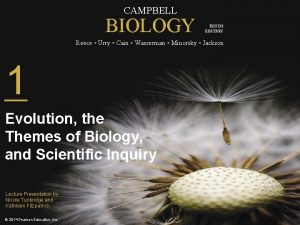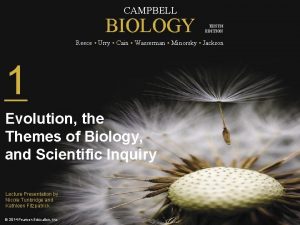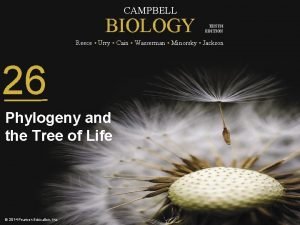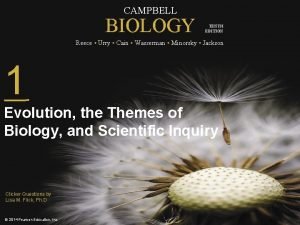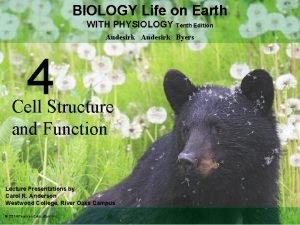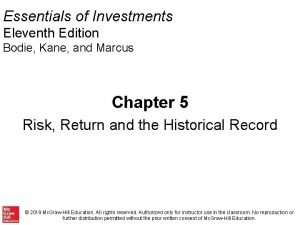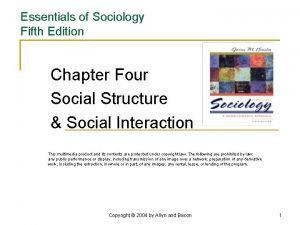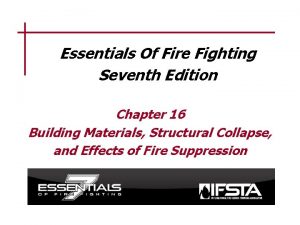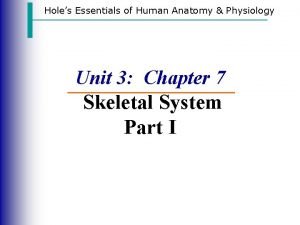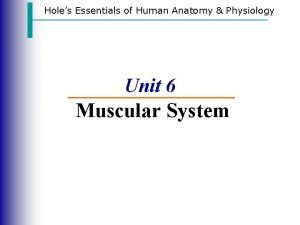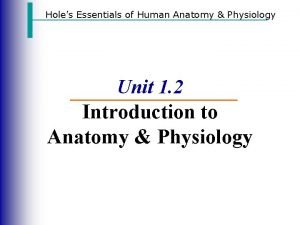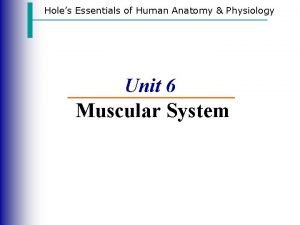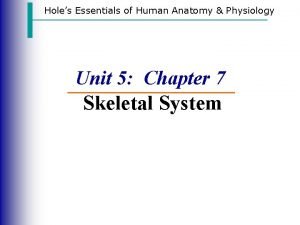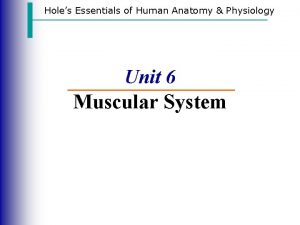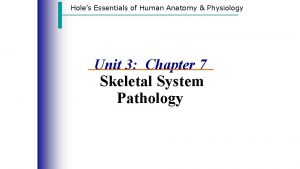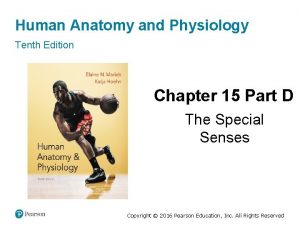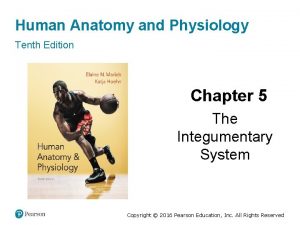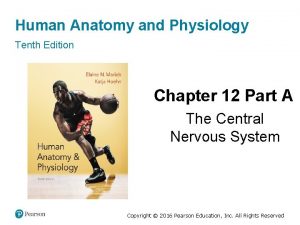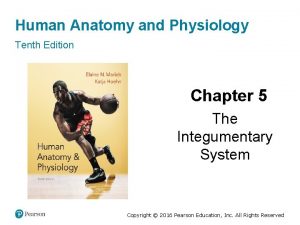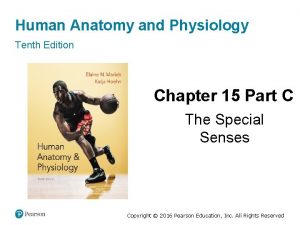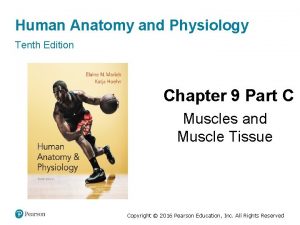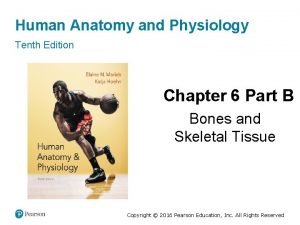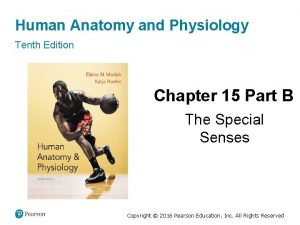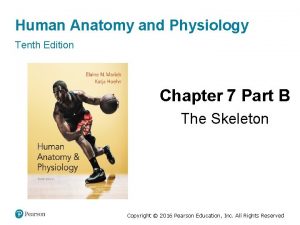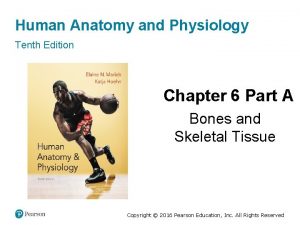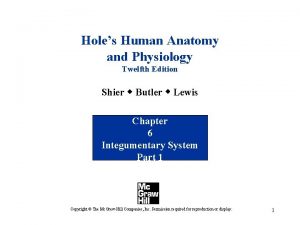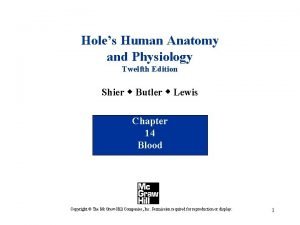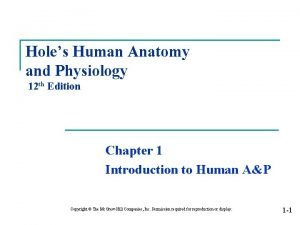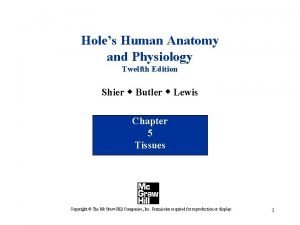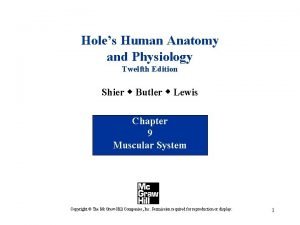Holes Essentials of Human Anatomy Physiology Tenth Edition









































- Slides: 41

Hole’s Essentials of Human Anatomy & Physiology Tenth Edition Chapter 7 Skeletal System Anatomy Part I

The Skeleton

Bone Markings · Surface features of bones · Sites of attachments for muscles, tendons, and ligaments · Passages for nerves and blood vessels · Categories of bone markings · Projections and processes – grow out from the bone surface · Depressions or cavities – indentations

The Axial Skeleton 80 bones · Skull including cranium (8) and facial (14) bones · Vertebral column including vertebrae (26) bones · Bony thorax including ribs (24) and sternum (1) · Hyoid bone singleton bone (1) · Middle ear bones including malleus (2), incus (2) and stapes (2)

The Skull · Two sets of bones · Cranium · Encloses brain tissue & protects the brain; surface allows for muscle attachment; some bones lined with sinuses · Composed of 8 flat bones: 4 single; 2 paired (parietal and temporal) · Facial bones · Composed of 14 bones: 6 paired; 2 single (mandible and vomer) · Hold eyes in anterior position and allow for facial expression · 13 of the 14 facial bones are joined by immovable sutures · Sutures are interlocking, immobile joints · Only the mandible is attached by a freely movable joint held to the rest of the skull by ligaments Slide 7. 6 b

The Skull · Cranium Frontal bone (1) · Forms anterior portion of the skull above the eyes · Upper margin of each orbit is marked by a supraorbital foramen (or supraorbital notch in some skulls) for blood vessels and nerves to pass to the tissues of the forehead (lower margin= infraorbital foramen) · Contain the frontal sinuses, one above each eye near the midline · Fuse with the parietal bones to form the coronal suture Parietal bones (2) · Located on each side of the skull just behind the frontal bone · Form the bulging sides and roof of the cranium · Fuse at midline along the sagittal suture and meet the frontal bone along the coronal suture Slide 7. 6 c

The Skull · Cranium Occipital bone (1) · Form the back of the skull and base of the cranium · Large opening called the foramen magnum allows nerves to pass from the brain, which enter the vertebral canal to become the spinal cord · Rounded processes called occipital condyles are located at either side of the foramen magnum to articulate with the first cervical vertebra (atlas). · Fuse with the parietal bones along the lambdoid suture Slide 7. 6 d

The Skull · Cranium Temporal bone (2) · Form parts of the sides and base of the cranium · Located near the inferior margin is an opening, the external auditory meatus, which lead to parts of the ear · Rounded projections below the external auditory meatus anchor muscles of the head and neck (mastoid process) and tongue and pharynx (styloid process) · Joining the zygomatic bone of the face is the zygomatic process, forming the superior prominence of the arch of the cheek · Depressions called mandibular fossae articulate with the mandibular condyles · Openings in the temporal bone allow for blood vessels to bring blood to the brain (carotid canals) and return blood back to the heart (jugular foramen) · On each side of skull, the temporal bones join the parietal bones along the squamous suture Slide 7. 6 e

The Skull · Cranium Sphenoid bone (1) · Consists of a central part creating the base of the skull and two wing -like structures that extend laterally toward each side of the skull · It also helps to form the floors and sides of the orbits · Along the midline of this bone is an indention, the sella turcica, which houses the pituitary gland. · The sphenoid bone also houses two sphenoid sinuses · The foramen ovale allows the cranial nerve #5 to supply nerves to the chewing muscles of the face Slide 7. 6 f

The Skull · Cranium Ethmoid bone (1) · The ethmoid bone is located in front of the sphenoid bone · Two masses on either side of the nasal cavity joined horizontally by the cribriform plates · Central to the cribriform plates is a triangular process called the crista galli which attaches the dura mater of the brain to the skull · A perpendicular plate projects downward in the midline of the cribriform plates and forms most of the nasal septum · From the lateral portions of the ethmoid bone twoard the perpendicular plate are scroll-shaped plates called superior nasal conchae and middle nasal conchae · The ethmoid bone also houses many small air spaces called ethmoid sinuses Slide 7. 6 g

The Skull · Facial Bones Maxillae bones (2) · Form upper jaw · Portions of these bones comprise the anterior roof of the mouth (hard palate), floor of the orbits, sides and floor of nasal cavity, sockets of the upper teeth · Inside the maxillae are (maxillary sinuses), the largest of the sinuses, are lateral to the nasal cavity · The palatine process is the portion of the maxillae that grow together and fuse along the midline to form the anterior section of the hard palate · The inferior border of each maxillary bone projects downward to form the horse-shoe alveolar process and alveolar arch which hold teeth. Slide 7. 6 h

The Skull · Facial Bones Palatine bones (2) · L-shaped bones located behind the maxillae · Horizontal portions form the posterior section of the hard palate and floor of the nasal cavity · Perpendicular portions help form the lateral walls of the nasal cavity Zygomatic bones (2) · Form the prominences of the cheeks below and to the sides of the eyes · Form the lateral walls and floors of the orbits · Contain a temporal process, which extends to join the zygomatic process of the temporal bone, together forming the zygomatic arch Slide 7. 6 i

The Skull · Facial Bones Lacrimal bones (2) · Thin, scalelike structure in the medial wall of each orbit between the ethmoid bone and maxilla · Contains the tear duct Nasal bones (2) · Long, thin and nearly rectangular · Lie side-by-side and fuse at the midline to form the bridge of the nose Vomer bone (1) · Thin, flat bone located along the midline within the nasal cavity · Posteriorly, the vomer joins the perpendicular plate of the ethmoid bone, and together form the nasal septum Slide 7. 6 j

The Skull · Facial Bones Inferior nasal conchae bones (2) · Fragile, scroll-shaped bones attached to the lateral walls of the nasal cavity · Support mucous membranes within the nasal cavity Mandible bone (1) · Horizontal, horseshoe-shaped body with a flat portion, mandibular ramus, projecting upwards at each end · The mandibular ramus contains two process, a posterior mandibular condyle and an anterior cornoid process · A curved bar of bone on the superior border of the mandible form the alveolar arch, which holds hollow sockets that bear the lower teeth Slide 7. 6 k

Human Skull, Lateral View 8 cranium bones: frontal; parietal (2); temporal (2); occipital; sphenoid; & ethmoid Slide 7. 6 l

Human Skull, Anterior View 14 cranial bones: maxillae; palatine; zygomatic; lacrimal; nasal; vomer (1); inferior conchae; mandible (1) Slide 7. 6 m

Human Skull, Superior View Slide 7. 6 n

Human Skull, Inferior View Slide 7. 6 o

The Hyoid Bone · The only bone that does not articulate with another bone · Suspended in midneck; anchored to styloid process of temporal bone · Serves as a moveable base for the tongue Slide 7. 6 r

Paranasal Sinuses · Air-filled, hollow portion of skull bones · Lined with mucous membranes and connected by passageways to the nasal cavity · Paranasal sinuses function to lighten the skull and give resonance and amplification to voice Slide 7. 6 p

Infantile Skull Fontanels – fibrous membranes connecting the cranial bones at birth • Soft spots allow the brain to grow and convert to bone within 2 years • Become the sutures of the adult skull The infantile skull is large compared to the infants total body length • Fetal skull ~1/4 the length of the body • Adult skull ~1/8 the length of the body The infantile skull includes: • a small face with a prominent forehead and large orbits • A jaw and nasal cavity that are small • Incompletely formed sinuses • A frontal bone is in two parts Slide 7. 6 q

The Vertebral Column · Vertebrae separated by intervertebral discs · Flexible fibrocartilage that cushion vertebra and absorb shock · The spine has a normal curvature · Thoracic & Sacral curvature = Primary/Convex · Cervical & Lumbar curvature = Secondary/Concave · Abnormal curvature: · scoliosis (lateral curve) · kyphosis (excess cervical curve) · lordosis (excess lumbar curve) · Each vertebrae is given a name according to its location Slide 7. 7 a

Structure of a Typical Vertebrae • • Body: weight bearing portion Vertebral arch: formed by the pedicles, laminae and spinous processes Vertebral foramen: spinal cord canal Transverse process: lateral projections ligaments and muscles attach Spinous process: posterior projection ligaments and muscles attach Articular processes: (superior and inferior) articulation projections allowing for joints between vertebra Intervertebral foramina: provide passageways for spinal nerves Slide 7. 7 b

Specific Characteristics of Vertebrae CERVICAL • 7 total • Transverse processes have transverse foramina, passageways for arteries leading to the brain • 2 nd -5 th spinous process is bifid • Atlas, supports the head with superior facets that articulate with the occipital condyle • Axis, bears a tootlike dens (odontoid process) and lies in the ring of the atlas • The atlas pivots around the dens THORACIC • 12 total • Long spinous process, sloping downward • Facets on the sides of their bodies articulate with ribs • Bodies increase in size to bear increasing loads of weight LUMBAR • 5 total • Large, stronger bodies SACRUM • 5 fused bones in 1 COCCYX • 4 fused bones in 1 Slide 7. 7 c

Regional Characteristics of Vertebrae Slide 7. 7 d

Regional Characteristics of Vertebrae Slide 7. 7 e

The Bony Thorax (a. k. a. Thoracic Cage) · Forms a cage to protect major organs · Made-up of: · Sternum · Ribs · Thoracic vertebrae · Costal cartilage Slide 7. 8 a

The Appendicular Skeleton 126 bones · Limbs (appendages) · Pectoral girdle · Pelvic girdle Attach limbs to axial skeleton ·“Girdle” suggests a ring-shaped structure, but the pectoral girdle is incomplete on the posterior between the scapulae and the sternum separates its bones on the anterior. Slide 7. 9 a

The Pectoral (Shoulder) Girdle · Composed of two bones · Clavicle – collarbone · Slender, rodlike bones with elongated “S” shape. · Acts as a brace to hold arm away from thorax · Scapula – shoulder blade · Broad, triangular bones. Not directly attached to axial skeleton. Held in place by trunk muscles · These bones allow the upper limb to have exceptionally free movement (3 reasons) · Attached to axial skeleton only at sternoclavicular joint · Loose attachment of scapula · Shallow glenoid cavity (poor reinforcement of shoulder joint by ligaments) Slide 7. 9 b

Bones of the Pectoral Girdle Clavicle • Attached to manubrium (of sternum) and acromion (of scapula) • Acromial (lateral) end & Sternal (medial) end Slide 7. 9 c

Bones of the Pectoral Girdle Scapula 2 processes: • Acromion process: connects with clavicle; Coracoid process: muscle attachment • Suprascapular notch: passageway for nerves • 3 borders (lateral, medial & superior) • 3 angles (lateral, inferior & superior) • 2 fossa (supraspinous & infraspinous) • Glenoid cavity: socket that receives the head of the humerus • Spine Slide 7. 9 d

Bones of the Upper Limb · The arm is formed by a single bone · Humerus · Head: fits into glenoid cavity of scapula · Greater and lesser tubercle: pts of muscle attachment; Intertubercular groove between. · Deltoid tuberosity: pt of deltoid muscle attachment · Radial groove: pt of nerve · Lateral and medial epicondyles: flank coronoid fossa (anteriorly) and olecranon fossa (posteriorly). Fossa allow for ulnar processes to move freely. · Capitulum and Trochlea: articulation Slide 7. 10 a

Bones of the Upper Limb • The forearm has two bones • Ulna • Olecranon & Coronoid Processes fit into corresponding fossa on humerus • Trochelear notch articulates with trochea on humerus • Radius • Radial tuberosity: attachment point for biceps muscle • Two joints between radius and Ulna: proximal and distal radioulnar joints • Radius and Ulna connected by interosseous membrane Styloid Process Slide 7. 10 b

Bones of the Upper Limb · The hand · Carpals – wrist · 8 bones · Metacarpals – palm · 5 bones · Phalanges – fingers · 14 bones · Each finger has three bones (distal, middle and proximal) · The thumb has 2 bones (distal and proximal only) Slide 7. 10 c

Bones of the Pelvic Girdle · Consists of two hip bones (a. k. a. coxae or innominate bones), sacrum & coccyx to make up the pelvis · Composed of three pair of fused bones · Ilium “wings” · Ischium “sit bone” · Pubis · The total weight of the upper body rests on the pelvis · Provides attachment for lower limbs · Protects several organs · Internal Reproductive organs · Urinary bladder · Distal end of the large intestine Slide 7. 11 a

The Pelvis • Ilium connected with sacrum at the sacroiliac joint • Pubic bones connect in middle at symphysis pubis and form the pelvic arch • As the pubis curves posteriorly and inferiorly to join the ischium, the obturator foramen, the largest foramen in the skeleton, is formed. • True pelvis – surrounded by bone • False pelvis – superior to true pelvis; medial to flaring ilia Sacral promontory Obturator foramen Slide 7. 11 b

The Pelvis • Acetabulum: receives head of thigh bone Iliac fossa Allows passage of blood vessels and sciatic nerve to posterior leg Obturator foramen: Allows passage of blood vessels and nerves to anterior leg Slide 7. 11 c

Gender Differences of the Pelvic Girdle & Pelvic Cavity The female: • coxae are lighter, thinner, and have less obvious muscular attachments compared to males. • obturator foramina and acetabula are smaller and farther apart than those of a male. • pelvic cavity is wider in all diameters and is shorter, roomier and less funnel-shaped compared to males. • ischial spines and ischial tuberosities are greater than in a male. • sacrum is wider and the 1 st sacral vertebra projects forward to a lesser degree. • sacral curvature is bent more sharply posteriorly than in a male. • coccyx is more movable than that of a male. • pubic arch wider than 90 degrees Slide 7. 11 d

Bones of the Lower Limbs · Fovea capitis The thigh has one bone · Femur – thigh bone · Fovea capitis-pit on the head marking the attachment of a ligament · Two trochanters, greater and less, and gluteal tuberosity serve as muscle attachment points · Head articulates with acetabulum · Medial and lateral condyles articulate with tibia · Condyles separated by intercondylar notch on posterior and patellar surface on the anterior · The patella, kneecap, is located in a tendon that passes anteriorly over the knee. Slide 7. 12 a

· Bones of the Lower Limbs The leg has two bones · Tibia “shinbone” · Medial bone · Lateral and medial condyles articulate with femur · Patellar ligament attaches to tibial tuberosity · Medial malleolus forms the inner ankle and is an attachment for ligaments · On the lateral side is a depression articulating with the fibula · The distal end of the tibia articulates with the talus · Fibula · Lateral “stick” forming a proximal head and a distal lateral malleolus · No weight is placed on the fibula, nor does it articulate with the knee joint Slide 7. 12 b

Bones of the Lower Limbs · The foot · Made up of the ankle, the instep (sole) and toes. · Seven ankle (tarsal) bones · Tarsus – ankle, moves freely where it joins the tibia and fibula · Calcaneus – heel bone, located below the talus · Talus and Calcaneus bear most weight · Instep (metatarsus) – 5 Metatarsal bones form the sole of the foot; heads of metatarsals form ball of the foot · Toes – 14 phalanges Slide 7. 12 c
 Holes essential of human anatomy and physiology
Holes essential of human anatomy and physiology Endomysium
Endomysium Human anatomy and physiology 10th edition
Human anatomy and physiology 10th edition Anatomy and physiology ninth edition
Anatomy and physiology ninth edition Holes anatomy and physiology chapter 1
Holes anatomy and physiology chapter 1 Chapter 1 introduction to human anatomy and physiology
Chapter 1 introduction to human anatomy and physiology Medial lateral distal proximal
Medial lateral distal proximal Chapter 2 human reproductive anatomy and physiology
Chapter 2 human reproductive anatomy and physiology Campbell biology tenth edition
Campbell biology tenth edition Campbell biology tenth edition
Campbell biology tenth edition Campbell biology tenth edition
Campbell biology tenth edition Elementary statistics tenth edition
Elementary statistics tenth edition Digital fundamentals 10th edition
Digital fundamentals 10th edition Corporate finance tenth edition
Corporate finance tenth edition Psychology tenth edition in modules
Psychology tenth edition in modules Introduction to genetic analysis tenth edition
Introduction to genetic analysis tenth edition Corporate finance tenth edition
Corporate finance tenth edition Corporate finance tenth edition
Corporate finance tenth edition Corporate finance tenth edition
Corporate finance tenth edition Corporate finance tenth edition
Corporate finance tenth edition Biology tenth edition
Biology tenth edition The graph shows data from the light colored soil
The graph shows data from the light colored soil Cloroplastos
Cloroplastos Biology tenth edition
Biology tenth edition Human anatomy fifth edition
Human anatomy fifth edition Human anatomy fifth edition
Human anatomy fifth edition William stallings network security essentials 5th edition
William stallings network security essentials 5th edition Business essentials 12th edition
Business essentials 12th edition Essentials of investments 11th edition
Essentials of investments 11th edition Understanding business 12th edition chapter 1
Understanding business 12th edition chapter 1 Essentials of sociology 5th edition
Essentials of sociology 5th edition Firefighter essentials 7th edition
Firefighter essentials 7th edition Business essentials 12th edition
Business essentials 12th edition The time/space collaboration and social tool matrix
The time/space collaboration and social tool matrix Essentials of organizational behavior 14th edition
Essentials of organizational behavior 14th edition Fire fighting methods
Fire fighting methods Network security essentials 5th edition
Network security essentials 5th edition Criminal justice wedding cake diagram
Criminal justice wedding cake diagram Physiology of sport and exercise 5th edition
Physiology of sport and exercise 5th edition Upper respiratory system
Upper respiratory system Tattoo anatomy and physiology
Tattoo anatomy and physiology Science olympiad anatomy and physiology
Science olympiad anatomy and physiology









